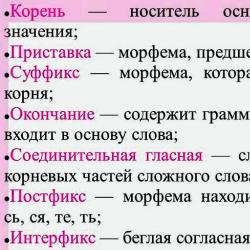What is alpha decay and beta decay? Beta decay, alpha decay: formulas and reactions. The phenomenon of radioactivity. Alpha and beta decay. Nuclear fission and fusion reactions. Classification of elementary particles. Quark hypothesis What happens during a reaction
Most atomic nuclei are unstable. Sooner or later they spontaneously (or, as physicists say, spontaneously) decay into smaller nuclei and elementary particles, which are commonly called decomposition products or child elements. Decaying particles are usually called starting materials or parents. All of the chemical substances we are familiar with (iron, oxygen, calcium, etc.) have at least one stable isotope. ( Isotopes are called varieties of a chemical element with the same number of protons in the nucleus - this number of protons corresponds to the atomic number of the element - but a different number of neutrons.) The fact that these substances are well known to us indicates their stability - which means they live long enough , in order to accumulate in significant quantities in natural conditions without breaking down into components. But each of the natural elements also has unstable isotopes - their nuclei can be obtained in the process of nuclear reactions, but they do not live long because they quickly decay.
Nuclei of radioactive elements or isotopes can decay in three main ways, and the corresponding nuclear decay reactions are named by the first three letters of the Greek alphabet. At alpha decay A helium atom consisting of two protons and two neutrons is released - it is usually called an alpha particle. Since alpha decay entails a decrease in the number of positively charged protons in an atom by two, the nucleus that emitted the alpha particle turns into the nucleus of an element two positions lower from it in the periodic table. At beta decay the nucleus emits an electron and the element moves one position forward according to the periodic table (in this case, essentially, a neutron turns into a proton with the radiation of this very electron). Finally, gamma decay - This decay of nuclei with the emission of high-energy photons, which are commonly called gamma rays. In this case, the nucleus loses energy, but the chemical element does not change.
However, the mere fact of instability of one or another isotope of a chemical element does not mean that by collecting together a certain number of nuclei of this isotope, you will get a picture of their instantaneous decay. In reality, the decay of the nucleus of a radioactive element is somewhat reminiscent of the process of frying corn when making popcorn: the grains (nucleons) fall off the “cob” (kernel) one at a time, in a completely unpredictable order, until all of them fall off. The law describing the reaction of radioactive decay, in fact, only states this fact: over a fixed period of time, a radioactive nucleus emits a number of nucleons proportional to the number of nucleons remaining in its composition. That is, the more grains-nucleons still remain in the “undercooked” cob-kernel, the more of them will be released during a fixed “frying” time interval. When we translate this metaphor into the language of mathematical formulas, we get an equation describing radioactive decay:
d N = λN d t
where d N— number of nucleons emitted by a nucleus with total number of nucleons N in time d t, A λ - experimentally determined radioactivity constant test substance. The above empirical formula is a linear differential equation, the solution of which is the following function, which describes the number of nucleons remaining in the nucleus at a time t:
N = N 0 e - λt
Where N 0 is the number of nucleons in the nucleus at the initial moment of observation.
The radioactivity constant thus determines how quickly the nucleus decays. However, experimental physicists usually measure not it, but the so-called half-life nucleus (that is, the period during which the nucleus under study emits half of the nucleons it contains). For different isotopes of different radioactive substances, half-lives vary (in full accordance with theoretical predictions) from billionths of a second to billions of years. That is, some nuclei live almost forever, and some decay literally instantly (here it is important to remember that after the half-life, half of the total mass of the original substance remains, after two half-lives - a quarter of its mass, after three half-lives - one eighth, etc. .d.).
As for the emergence of radioactive elements, they are born in different ways. In particular, the ionosphere (the thin upper layer of the atmosphere) of the Earth is constantly bombarded by cosmic rays consisting of high-energy particles ( cm. Elementary particles). Under their influence, long-lived atoms are split into unstable isotopes: in particular, from stable nitrogen-14 in the earth’s atmosphere, the unstable isotope carbon-14 with 6 protons and 8 neutrons in the nucleus is constantly formed ( cm. Radiometric dating).
But the above case is rather exotic. Much more often, radioactive elements are formed in reaction chains nuclear fission . This is the name given to a series of events during which the original (“mother”) nucleus decays into two “daughter” (also radioactive), which, in turn, decay into four “granddaughter” nuclei, etc. The process continues until until stable isotopes are obtained. As an example, let's take the isotope uranium-238 (92 protons + 146 neutrons) with a half-life of about 4.5 billion years. This period, by the way, is approximately equal to the age of our planet, which means that approximately half of the uranium-238 from the composition of the primary matter of the formation of the Earth is still found in the totality of elements of earthly nature. Uranium-238 turns into thorium-234 (90 protons + 144 neutrons), which has a half-life of 24 days. Thorium-234 turns into palladium-234 (91 protons + 143 neutrons) with a half-life of 6 hours - etc. After more than ten decay stages, the stable isotope of lead-206 is finally obtained.
There is a lot that can be said about radioactive decay, but a few points deserve special mention. Firstly, even if we take a pure sample of any one radioactive isotope as a starting material, it will decay into different components, and soon we will inevitably get a whole “bouquet” of different radioactive substances with different nuclear masses. Secondly, the natural chains of reactions of atomic decay reassure us in the sense that radioactivity is a natural phenomenon, it existed long before man, and there is no need to take it upon ourselves and blame human civilization alone for the fact that there is background radiation on Earth. Uranium-238 has existed on Earth since its very inception, has decayed, is decaying - and will continue to decay, and nuclear power plants accelerate this process, in fact, by a fraction of a percent; so they do not have any particularly harmful effects on you and me in addition to what is provided by nature.
Finally, the inevitability of radioactive atomic decay poses both potential problems and potential opportunities for humanity. In particular, in the chain of reactions of the decay of uranium-238 nuclei, radon-222 is formed - a noble gas without color, smell and taste, which does not enter into any chemical reactions, since it is not capable of forming chemical bonds. This inert gas, and it literally oozes from the depths of our planet. Usually it has no effect on us - it simply dissolves in the air and remains there in a slight concentration until it breaks down into even lighter elements. However, if this harmless radon remains in an unventilated room for a long time, then over time its decay products will begin to accumulate there - and they are harmful to human health (if inhaled). This is how we get the so-called “radon problem”.
On the other hand, the radioactive properties of chemical elements bring significant benefits to people if we approach them wisely. Radioactive phosphorus, in particular, is now injected to produce a radiographic picture of bone fractures. The degree of its radioactivity is minimal and does not cause harm to the patient’s health. Entering the bone tissue of the body along with ordinary phosphorus, it emits enough rays to record them on light-sensitive equipment and take pictures of a broken bone literally from the inside. Surgeons, accordingly, have the opportunity to operate on a complex fracture not blindly and at random, but by studying the structure of the fracture in advance using such images. In general, applications radiography there are countless numbers in science, technology and medicine. And they all work on the same principle: the chemical properties of an atom (essentially, the properties of the outer electron shell) make it possible to assign a substance to a certain chemical group; then, using the chemical properties of this substance, the atom is delivered “to the right place”, after which, using the property of the nuclei of this element to decay in strict accordance with the “schedule” established by the laws of physics, the decay products are recorded.
The structure and properties of particles and atomic nuclei have been studied for about a hundred years in decays and reactions.
Decays represent the spontaneous transformation of any object of microworld physics (nucleus or particle) into several decay products:
Both decays and reactions are subject to a number of conservation laws, among which the following laws should be mentioned, firstly:
In the future, other conservation laws operating in decays and reactions will be discussed. The laws listed above are the most important and, what is especially significant, are performed in all types of interactions.(It is possible that the law of conservation of baryon charge does not have such universality as conservation laws 1-4, but its violation has not yet been discovered).
The processes of interactions between objects of the microworld, which are reflected in decays and reactions, have probabilistic characteristics.
Decays
Spontaneous decay of any object of microworld physics (nucleus or particle) is possible if the rest mass of the decay products is less than the mass of the primary particle.
Decays are characterized decay probabilities
, or the inverse probability of average life time
τ = (1/λ). The quantity associated with these characteristics is also often used half-life
T 1/2.
Examples of spontaneous decays
π 0 → γ + γ; π + → μ + + ν μ ; |
(2.4) | n → p + e − + e ; μ + → e + + μ + ν e ; |
(2.5) |
In decays (2.4) there are two particles in the final state. In decays (2.5) there are three.
We obtain the decay equation for particles (or nuclei). The decrease in the number of particles (or nuclei) over a time interval is proportional to this interval, the number of particles (nuclei) at a given time and the probability of decay:
Integration (2.6) taking into account the initial conditions gives the relationship between the number of particles at time t and the number of the same particles at the initial time t = 0:
The half-life is the time during which the number of particles (or nuclei) decreases by half:
Spontaneous decay of any object of microworld physics (nucleus or particle) is possible if the mass of the decay products is less than the mass of the primary particle. Decays into two products and into three or more are characterized by different energy spectra of the decay products. In the case of decay into two particles, the spectra of the decay products are discrete. If there are more than two particles in the final state, the spectra of the products are continuous.
The difference in the masses of the primary particle and the decay products is distributed among the decay products in the form of their kinetic energies.
The laws of conservation of energy and momentum for decay should be written in the coordinate system associated with the decaying particle (or nucleus). To simplify the formulas, it is convenient to use the system of units = c = 1, in which energy, mass and momentum have the same dimension (MeV). Conservation laws for this decay:
From here we obtain for the kinetic energies of the decay products
Thus, in the case of two particles in the final state kinetic energies of products are determined definitely. This result does not depend on whether the decay products have relativistic or non-relativistic velocities. For the relativistic case, the formulas for kinetic energies look somewhat more complicated than (2.10), but the solution to the equations for the energy and momentum of two particles is again unique. It means that in the case of decay into two particles, the spectra of the decay products are discrete.
If three (or more) products arise in the final state, solving the equations for the laws of conservation of energy and momentum does not lead to an unambiguous result. When, if there are more than two particles in the final state, the spectra of the products are continuous.(In what follows, using the example of -decays, this situation will be considered in detail.)
In calculating the kinetic energies of nuclear decay products, it is convenient to use the fact that the number of nucleons A is conserved. (This is a manifestation baryon charge conservation law
, since the baryon charges of all nucleons are equal 1).
Let us apply the obtained formulas (2.11) to the -decay of 226 Ra (the first decay in (2.4)).
Mass difference between radium and its decay products
ΔM = M(226 Ra) - M(222 Rn) - M(4 He) = Δ(226 Ra) - Δ(222 Rn) - Δ(4 He) = (23.662 - 16.367 - 2.424) MeV = 4.87 MeV. (Here we used tables of excess masses of neutral atoms and the relation M = A + for masses, etc. surplus masses
Δ)
The kinetic energies of helium and radon nuclei resulting from alpha decay are equal to:
,![]() .
.
The total kinetic energy released as a result of alpha decay is less than 5 MeV and is about 0.5% of the rest mass of the nucleon. The ratio of the kinetic energy released as a result of the decay and the rest energies of particles or nuclei - criterion for the admissibility of using the nonrelativistic approximation. In the case of alpha decays of nuclei, the smallness of kinetic energies compared to rest energies allows us to limit ourselves to the nonrelativistic approximation in formulas (2.9-2.11).
| Problem 2.3. Calculate the energies of particles produced in meson decay |
The decay of the π + meson occurs into two particles: π + μ + + ν μ. The mass of the π + meson is 139.6 MeV, the mass of the μ muon is 105.7 MeV. The exact value of the muon neutrino mass ν μ is not yet known, but it has been established that it does not exceed 0.15 MeV. In an approximate calculation, we can set it equal to 0, since it is several orders of magnitude lower than the difference between the pion and muon masses. Since the difference between the masses of the π + meson and its decay products is 33.8 MeV, for neutrinos it is necessary to use relativistic formulas for the relationship between energy and momentum. In further calculations, the low neutrino mass can be neglected and the neutrino can be considered an ultrarelativistic particle. Laws of conservation of energy and momentum in the decay of the π + meson:
m π = m μ + T μ + E ν
|p ν | ![]()
= | p μ | 
E ν = p ν
An example of two-particle decay is also the emission of a -quantum during the transition of an excited nucleus to a lower energy level. In all two-particle decays analyzed above, the decay products have an “exact” energy value, i.e. discrete spectrum. However, a deeper consideration of this problem shows that
![]() .
.
the spectrum of even the products of two-particle decays is not a function of energy.
The spectrum of decay products has a finite width Γ, which is larger the shorter the lifetime of the decaying nucleus or particle.
(This relation is one of the formulations of the uncertainty relation for energy and time).
The neutron undergoes -decay, turning into a proton and two leptons - an electron and an antineutrino: np + e - + e.
Beta decays are also experienced by leptons themselves, for example, the muon (the average lifetime of a muon
τ = 2.2 ·10 –6 sec):
![]() .
.
Conservation laws for muon decay at maximum electron momentum:
For the maximum kinetic energy of the muon decay electron, we obtain the equation
|
The kinetic energy of the electron in this case is two orders of magnitude higher than its rest mass (0.511 MeV). The momentum of a relativistic electron practically coincides with its kinetic energy, indeed
p = (T 2 + 2mT) 1/2 = )






